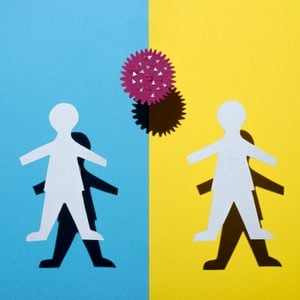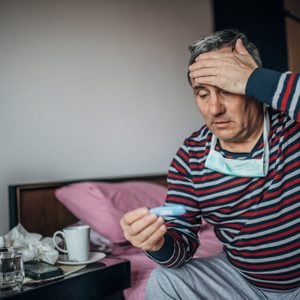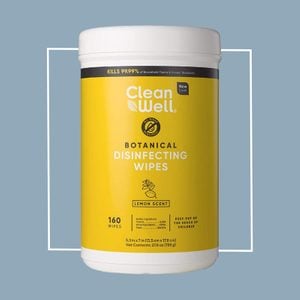Coronavirus and Super Spreaders: What the CDC Wants You to Know
Updated: Oct. 21, 2020
Super-spreader events—and super spreaders—can transmit a virus to many people all at once. The recent event in the Rose Garden may be an example.
On September 26, more than 150 people gathered in the White House Rose Garden to witness President Trump formally nominate Amy Coney Barrett to be the next justice of the Supreme Court. Face masks were few and far between and guests sat shoulder to shoulder in lawn seats before mingling at an indoor reception. More than a dozen of those attendees, including the president himself, have since tested positive for SARS-CoV-2, the virus that causes Covid-19.
The recent White House celebration has all the hallmarks of a “super spreader event.” “I think we will end up looking at it that way,” confirms David Eisenman, MD, director of the UCLA Fielding School of Public Health’s Center for Public Health and Disasters.
Who or what is a super spreader?
The term “super spreader” is not an easy one to pin down. “There’s not a hard and fast definition of super spreader in the scientific literature,” says Dr. Eisenman, who is also a professor at UCLA’s David Geffen School of Medicine.
In a general sense, it means a person or event that spreads the infection to more people than average. Of course, “average” is its own ambiguous term and depends greatly on the baseline rate of transmission in a particular community, says S. Wesley Long, MD, PhD, associate professor of pathology and genomic medicine at Houston Methodist Hospital. That means how many people one infected individual typically infects. Experts and academic literature refer to both super spreader events and super spreader people, which often overlap. (Find out why some people are more likely to spread Covid-19 than others.)

Super spreader events
Dr. Eisenman prefers to think of super spreader events, rather than people. (There can be a stigma when labeling someone this way.) Such an event would be “any event or incidence where more people got infected than you would expect in usual circumstances,” explains Dr. Eisenman. During the 2002-2003 SARS outbreak, one group of researchers defined a super spreader event as one in which eight or more people were infected, though this number will vary by virus.
There have been Covid-19 super spreader events. One was a choir rehearsal in Washington State at which 32 of 61 singers were infected. Those people then infected at least another 20 individuals. Another was a three-hour family dinner at a restaurant in China during the Chinese New Year. Nineteen people attended. Twelve people became infected.
How do super spreader events happen?
Experts point to a number of possible reasons. “First, there’s a possibility that someone is emitting a lot of viruses because they are anatomically that way,” says Dr. Eisenman. “Some people spread more droplets and aerosols than others or they have higher viral loads. They could [also] be right up in your face.”
It also has to do with the setting. An event taking place indoors in a poorly ventilated space is riskier than something outdoors in a well-ventilated space. How long people linger makes a difference, says Dr. Eistenman. Then there are the precautionary measures. “To have a super spreading event generally also requires letting down the safety measures that we know are helpful in mitigating the spread,” says David Hirschwerk, MD, an infectious diseases physician at Northwell Health in Manhasset, New York.
Super spreaders
There do seem to be certain people who spread different viruses more effectively than others, says Dr. Long. One example from the 2003 SARS outbreak was a flight attendant in Singapore who infected more than 100 patients with Covid-19, says Dr. Hirschwerk.
Why do some people appear to be more infectious? Again, no one is sure but there are several possible explanations, such as a more severe case of Covid-19, few or mild symptoms, or a higher viral load that results in more shedding of the virus, according to an article in the Journal of Hospital Infection.
How does Covid-19 spread?
According to the World Health Organization (WHO), Covid-19 can spread through direct contact with droplets from an infected person’s mouth or nose when they cough or even talk. The belief is that droplets, which are relatively heavy and sink to the ground, travel about six feet.
There’s been a lot of contention around whether aerosol droplets can spread the virus. These are “little droplets that are so light that don’t fall to the ground and linger in the air for minutes and even hours,” explains Dr. Eisenman. On Monday, October 5, the Centers for Disease Control and Prevention released a statement saying that Covid-19 could spread via the airborne spread of aerosol particles, though much less often than via the heavier droplets.
Asymptomatic transmission
Experts also now believe that the virus can easily be spread by people who are asymptomatic (they have no symptoms). “There does appear to be evidence that can transmit before they have symptoms and some have symptoms so mild that they write it off as cold and allergies,” says Dr. Long. “Silent spreaders” may be responsible for as many as half of Covid-19 cases, according to a July study in the Proceedings of the National Academy of Sciences.
The Rose Garden event
The Rose Garden event along with the indoor reception seem to qualify as super spreading events. Without contact tracing, it’s hard to know exactly what happened, says Dr. Long. “The likelihood of 10 or 20 people independently contracting the virus at different times in different locations is low,” he says. “It’s much more likely that they were at that event.”
There was certainly “a major lapse in adhering to the recommendations that we’ve all been hearing about consistently since the start of the pandemic: Primarily, trying to avoid indoor gatherings with groups of people that haven’t been in the same ‘pod’ like a family,” says Dr. Hirschwerk. “At the Rose Garden, in the pictures we all have, there was a very large group and individuals very close together and mask use was very minimal.”
How to protect yourself and others
Even with the updated CDC guidance about aerosolized transmission, the CDC and other organizations recommend the same measures to fend off this menacing virus. “The new CDC recommendations still make the case that wearing masks and distancing from people are the most important things you can do, and they add that being outdoors is always better than indoors,” says Dr. Eisenman. “It’s a layered approach: mask plus distance plus outdoors, or indoors in well-ventilated spaces. If you’re going to be indoors, wear the mask, keep the distance, but also reduce the amount of time you’re indoors. Keep it to as little a number of minutes and people as possible.” The bottom line, he adds, “is that you can never know when you’re walking into a super spreader event.” Or when you’re in contact with someone who has Covid-19.
The CDC also reminds people to sanitize or wash their hands frequently along with high-touch surfaces like doorknobs.
Winter is coming
The chances of the virus spreading are only going to get higher as we enter colder weather and people spend more time indoors. “We need to take care, especially as we go into the winter to be in well-ventilated spaces and as much as possible outdoors,” says Dr. Eisenman. “We need to be thinking how much more we could be doing outside.” And don’t forget that flu season is almost here—here’s how to tell flu symptoms vs. Covid-19 symptoms.
“We are not even close to the point where we can resume what we could call normal activity,” says Dr. Hirschwerk. “This is a virus that we’re going to be living with for quite some time.”



